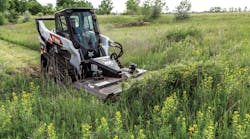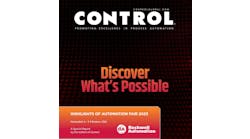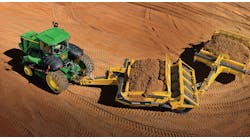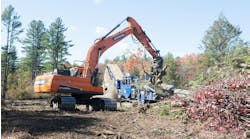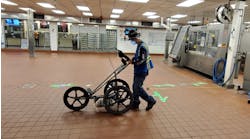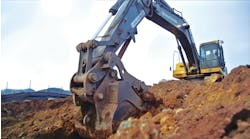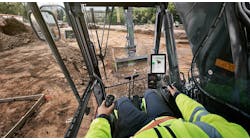Skid-steers and compact track loaders have been considered efficient, reliable workhorses on job sites for years. With the addition of numerous attachments, the versatility of these compact machines has convinced contractors of the importance of including them in their fleets.
They are the most versatile pieces of equipment you can own, says Kevin Coleman, product specialist for Caterpillar—and with the variety of attachments available, he believes there’s “almost nothing [they] can’t help a customer do better, [more easily], or more efficiently.”
As customers began to realize the value of productivity and performance features that compact equipment offers to help them complete jobs quickly and easily, Luke Gribble, solutions marketing manager-Aggregates/Wheel Loaders, Skid Steers, and CTLs for John Deere Construction & Forestry, says they are moving into rental fleets and other segments of the industry, such as landscaping, construction, and agriculture. “Machine performance is key, but when you start adding attachment offerings into the mix, it only increases the need for customers to have one of these machines in their fleet. Their smaller size and maneuverability, compared [with] other pieces of construction equipment, [are] also advantage[s], making them easy to transport from job site to job site."
It’s difficult to beat the versatility, productivity, and maneuverability of compact equipment. They can work in tight spaces where heavy equipment cannot. And because of their versatility through the use of task-specific attachments, these multi-functional machines can do the work of multiple machines. “Fewer pieces of equipment may be needed to complete a job,” states Sarah Peckskamp, marketing manager, Bobcat.
Good in poor conditions as well as tight spaces, CTLs are known to work in many soil types and conditions, Peckskamp points out. “In addition to improved traction in muddy, sandy, or wet ground conditions, compact track loaders offer lower ground disturbance to finished surfaces.”
Job Sites Big and Small
Just because they’re small doesn’t mean they are restricted to small jobs. “Skid steers and CTLs play very useful roles on any job site, large or small," Gribble states. On smaller job sites, they may be the main piece of equipment, used for grading, land clearing, or material handling. Deere's 333G SmartGrade CTL can be used for final and finish grading once the larger equipment has gotten to a point where the grade is very close to finish. On larger jobs, he notes that they shine in tight spaces and hard-to-reach areas.
Sometimes they’re used in a supporting role for bigger equipment, but Coleman believes that for many tasks, they provide value on their own. “These machines are the most versatile pieces of equipment you can own,” he insists. They can be used for basic digging and material handling with a bucket or fork, but if you switch attachments, they can also be used for grading.
Compact equipment is doing more than just squeezing into tight spaces. Peckskamp says the new R-Series loaders from Bobcat are being used to complete bigger jobs—and in less time. Balancing durability and reliability, they must also deliver performance by lifting more and running harder to tackle the big jobs.
Combo Power
With the difficulty of finding labor today, having a machine that can do the work of two makes a difference. Mecalac North America’s Mecalac Crawler Rapid does just that, according to Peter Bigwood, general manager. The MCR (the smallest of which is 6 tons) is a combination of compact excavator, track loader, and material loader, with a versatile arm system that can work like a crane or a telehandler.
The unique arm is one of the keys to the MCR’s design. There are three parts to the boom, including the dipper stick. One part of the two-piece boom is articulated, offset, and built-in. This attached part of the boom can fold backward, providing more capacity to lift the weight. Because the boom folds in, it’s even more compact, bringing the full bucket closer to the body of the compactor, unlike machines equipped with the standard one-piece boom and dipper that stick out farther.
Another key to its design is the MCR’s ability to switch from excavator bucket to loader bucket with a quick coupler. The bucket nestles into the dozer blade to work like a CTL. “You can lift the bucket higher to unload or you can turn 180 degrees and dump behind without spinning the tracks,” Bigwood explains.
The third design key is the MCR’s speed, which Bigwood says is “double any other mini excavator or compact track excavator.” In addition to speed, as with other compact equipment, it’s versatile and saves money, Bigwood states. He says one customer found it more effective to take the MCR to a pipeline job; with only one operator and one machine, they saved labor, money, and time.
While the MCR has been on the European market for 10 years, Mecalac introduced an “MCR evolution” specifically for the North American market at CONEXPO: a thumb. The MCR now features an excavator-style boom with the cylinder above in the traditional spot so there’s room to have a hydraulic thumb. Other improvements include more legroom and a 7-in. color monitor in the cab and 260-degree vision with camera options.
New and Improved
Mecalac isn't the only company making improvements to its compact equipment. Deere’s current lineup of G-series skid steers and CTLs offers many features that benefit customers, such as extreme pushing power and bucket breakout forces that allow customers to handle heavier loads and power through piles more easily. “There have also been increases in auxiliary hydraulic flow and power to get the most productivity out of the more than 100 attachments that John Deere has available from the factory,” Gribble notes. Another key addition is the optional boom performance package that can help shorten cycle times and speed up production by automating repetitive boom functions like return to dig, return to carry, and boom height kick out.
All Cat D3 Series CTLs feature standard two-speed travel, but Cat increased speed on its 279D3 and 289D3 loaders by 20%, which now tops out at 8.4 mph. They are geared to deliver high torque digging performance as well as high top-end speed for travel.
Changes to the undercarriage frame and torsion axles on all Cat D3 Series CTLs reduce machine pitching and rocking, while still offering ride comfort. The standard torsion suspension also delivers improved operating stability while handling heavy loads, grading, or truck loading.
In addition to Cat’s eight SSL models and seven CTL models covering a range of sizes, horsepower, and operating capacities, its D3 series also includes the purpose-built Cat 299D3 XE Land Management CTL. According to Coleman, it delivers “superior performance in demanding vegetation-management applications, such as mulching, brush cutting, vegetation control, and mowing.” It also features a turbocharged 110 gross horsepower Cat C3.8 engine that combines with a 40 GPM high-flow/high-pressure auxiliary hydraulic system to produce a hydraulic horsepower rating of 94 hp for powering high-production hydromechanical attachments like mulching heads.
The Land Management CTL’s fuel capacity is 80% larger than the standard 299D3 XE model’s, for an estimated run time of 11 to 12 hours. The cooling system’s hydraulically driven fan operates only when required to save fuel, while the reversing fan feature clears intake screens of debris, so the system runs cooler when operating in high ambient temperature applications.
It features additional seals, covers, and other parts to restrict debris and other materials from entering the engine compartment and lower frame, as well as a turbine-type pre-cleaner that ejects dust, dirt, and debris from engine-intake airflow before it reaches the filter. Additional factory-equipped components provide guarding to protect front and rear LED work lights, work-tool coupler area, work-tool electrical harness connections, and auxiliary-hydraulic quick-disconnect fittings from impact and debris that are often hazards in land-clearing applications.
Meanwhile, Bobcat focuses on developing digital solutions that generate and utilize actionable data to improve productivity and provide more automation. This is incorporated in MaxControl, which allows remote operation of the compact loader from outside the cab using an iPhone to set up geofences or plot points on a digital worksite for semi-autonomous operation.
Bobcat Machine IQ Wireless Communications, Bobcat’s telematics system, provides information such as hours in use, fuel level, equipment location, critical fault codes, and service milestones.
Attached to New Ideas
Coleman proclaims an industry “first” in that all Cat D3 Series SSL and CTL models support a line of innovative smart attachments with a higher level of integration to provide better machine utilization and a better-finished product by delivering easy, intuitive operation.
The new Smart Technology and Smart Attachments offer attachment recognition, tailored controls, and special information/control screens. The technology starts with “plug & play” attachment recognition; the machine understands when and which smart attachment is connected.
Once in the Attachment Control mode, the machine’s existing joystick controls are changed from the traditional drive/implement control functionality to meet the control needs for the specific attachment. With a simple press of the button, the operator returns to Machine Control mode and the joysticks return to their original drive and implement control functionality.
Smart Attachments for Cat CTLs include:
The Smart Backhoe: In-cab joystick controls are converted to allow control of boom, stick, bucket, swing, stabilizer movement, and side shift. Due to this integration, the need to remove the door to operate a Backhoe attachment has been eliminated, allowing for safer, more comfortable operation from inside the one-piece, sealed and pressurized cab: no more concerns about the rain, cold, or heat.
The Smart Dozer with Assist: Attachment recognition allows the D3 CTL to be controlled more like a full-size dozer. With assist enabled, it becomes even easier to get a smoother grade with fewer passes and helps eliminate the washboard effect associated with CTL dozer blade attachments.
The Smart Grader with Assist: To assist with grading dirt, gravel, and sand, the grader blade has enhanced performance and functionality via the cross-slope assist feature to maintain the desired slope. The Smart Grader can also be combined with 2-D or 3-D external reference systems for even higher levels of grading accuracy.
Cab-In Fever
Cabin improvements often result in increased productivity and operator retention. Bobcat’s R-Series compact track loaders offer advanced features that make a long workday more comfortable and productive, according to Peckskamp. The clear-side enclosure eliminates the need for steel mesh on the cab’s side windows, maximizing side visibility. Bobcat’s patented 5-link Torsion Suspension undercarriage option reduces stress and vibration from the undercarriage for a more comfortable ride.
Peckskamp believes the most important piece of technology in a compact loader is the display. Bobcat’s new 7-inch touchscreen display option offers Bluetooth connectivity with the ability to make hands-free phone calls, active noise-canceling technology, and other features including the integrated on-demand review camera and attachment control for select attachments.
Cat starts at the beginning: entrance and exit of the one-piece, sealed and pressurized cab of the D3 Series SSLs and CTLs is easier, thanks to a cab door that opens up to 40%wider than the previous model series. “Additionally,” says Coleman, “operator comfort has been increased, with the distance between joystick pods having been enlarged by three inches, offering extra space for the operator inside the cab.”
On select John Deere models, customers can choose from a canopy-style or fully enclosed cab. “Creature comforts like optional heated and air suspension seat and Bluetooth radio are great additions for keeping operators comfortable throughout the entire day,” Gribble says.
“Choosing the control style that best suits operator needs is important on these machines,” Gribble continues. That’s why JD offers an optional four-way switchable control package that lets operators choose between EH foot controls, ISO joystick controls, H-pattern joystick controls, or a combination of ISO and foot controls on select models.
A Small Advantage
Compact equipment is typically more nimble than bigger machines and usually comes at a lower cost of ownership. Yet, it often performs much of the same work. The versatility added through attachments has contributed to making the compact equipment market a strong one, as contractors have discovered multiple reasons to keep these little reliable workhorses in their fleets.
